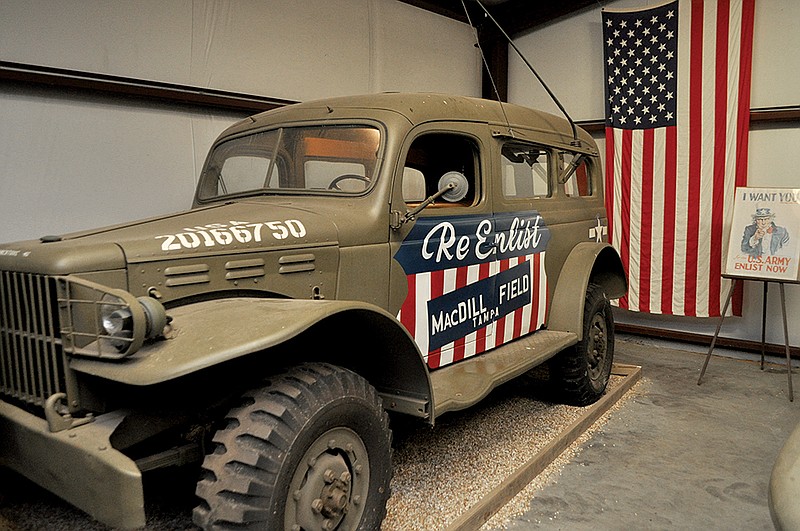If the equipment worked, the Grant County Museum would be one of the most well-defended places in Arkansas.
The cluster of white buildings just a mile or so outside Sheridan has scores of rifles, machine guns, even some cannons. There are also plenty of olive-drab vehicles to move the weapons around.
“Unfortunately, they’re not in any shape to run,” said Jase Goins, office manager for the museum, who led a tour of the military equipment found among the displays. “Fixing them would be one of those dream projects for the future.”
Inside the main museum, there is a jeep equipped with radio equipment along with a strange little tracked vehicle big enough to fill the bed of a pickup truck.
Built by Studebaker during World War II, the vehicle is just like one purchased by Sheridan High School students in 1945. Wanting to help the war effort in its final months, the students sold stamps and raised $4,815 to buy the little vehicle.
With the tracks of a tank, the body of the vehicle is almost like a box with the top off. The armored vehicle has only a canvas roof. Information at the display said the vehicle could cross through mud and swamps where other vehicles, even the reliable Army jeep, could not go. The tracked vehicle was used to carry supplies and radio equipment, or as a command car for officers. The little swamp vehicle could also be used as an ambulance to carry the wounded back from the soggy battlefields in the Pacific Theater.
Behind the main museum is a metal building that holds the major part of the collection and the largest of the traveling war machines.
The biggest of all is Big Bertha, the name painted on the front. It is a 13-ton tractor with tank-like tracks and stands taller than the average man by several feet. Used throughout World War II, the International Harvester tractor has a two-seat cab and a big open box of a bed surrounded by armor.
Despite the size, Bertha served much the same purpose as the little swamp buggy purchased by the students. Bertha could tow other vehicles from the front lines and resupply troops near the fighting with ammunition and weapons. It could also carry small artillery and serve as a firing platform.
Perhaps the most impressive piece of battle equipment in the museum’s collection is a half-track, tall and long with a white American star stencilled on its hood. The front is an armored truck,and past the two-seat, open cab, the vehicle has walls of tall armor plate and room for a squad of soldiers. For the half-track’s protection, a large machine gun is mounted on a pole so it can rotate to face all directions.
In the the back of the half-track stands a mannequin soldier dressed in survival gear against a gas or chemical warfare attack.
The goggled troop also has a cigarette in its mouth. Goins said it is there to check the reaction of children.
“They are always amazed to learn that soldiers were given tobacco with their food supplies,” he said. “They always say, ‘But it’s not good for you,’ and we tell them almost no one knew that then.”
Other vehicles include a more-common combat ambulance, trucks and vans for moving supplies. One vehicle in the back has a bright 48-star American flag on the side. It was a vehicle used to promote enlistment during World War II, especially to the MacDill Army Air Corps Camp near Tampa, Fla.
The vehicles came from the collection of Richard Harrison of Little Rock, said Ron Gortney, who has been with the museum for years.
“He was in World War II in Hawaii, where he was involved in secret communications of some type, I understand,” Gortney said. “He was also commander of the Civil Air Patrol in Little Rock, a member of the U.S. Coast Guard Auxiliary and an official in the National Rifle Association in Little Rock.”
Gortney said Harrison was approached by museum founder Eldwin Goolsby about a collection of rifles and other weapons that is now part of the museum’s exhibits.
“Harrison had his own museum at the welding-
supply company he owned, and it included a vehicle gallery,” Gortney said. “Goolsby asked about it, and Harrison said if the museum would build a building, they could have all the vehicles they wanted.”
The requested structure now houses the larger vehicles, and the collection of other items is on display at the Grant County Museum, 151 Shackleford Road, from 9 a.m. to 4 p.m. Tuesdays through Saturdays. There are also many displays of Grant County history, including artifacts of the Battle of Jenkins Ferry during the Civil War and items from everyday life in Sheridan and rural Grant County. For more information, call (870) 942-4496.
Staff writer Wayne Bryan can be contacted at (501) 501-244-4460 or at wbryan@arkansasonline.com.
